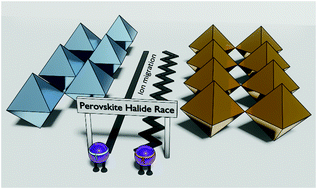Voltage bias stress effects in metal halide perovskites are strongly dependent on morphology and ion migration pathways†
Abstract
The solar-to-power power conversion efficiencies (PCEs) of metal halide perovskites (MHP) have improved over the last decade using a wide variety of methods, including composition manipulation, dopant introduction, and interfacial buffers. These methods, however, have taken little regard for the electronic and interfacial effects such alterations may cause within devices under voltage bias stress – a condition required for most device operation. We investigate how halide and cation substitution in MHP structures [specifically, CH3NH3PbI2.87Cl0.13 and Cs0.1(MA0.17FA0.83)0.9Pb(I0.83Br0.17)3] effects the current behavior of devices while under a range of voltage bias stress in both light and dark conditions. Conducting in depth investigations into the electronic and morphological differences between these two MHP devices, we confirmed their unique voltage bias stress effects are due to intrinsic behavior within the perovskite structure. Importantly, we also determined how crystallite orientation can influence ion migration and therefore alter charge transport and current stability in MHP photovoltaic devices.

- This article is part of the themed collection: 2022 Journal of Materials Chemistry Lectureship runners-up: Jessica Wade and Luisa Whittaker-Brooks


 Please wait while we load your content...
Please wait while we load your content...